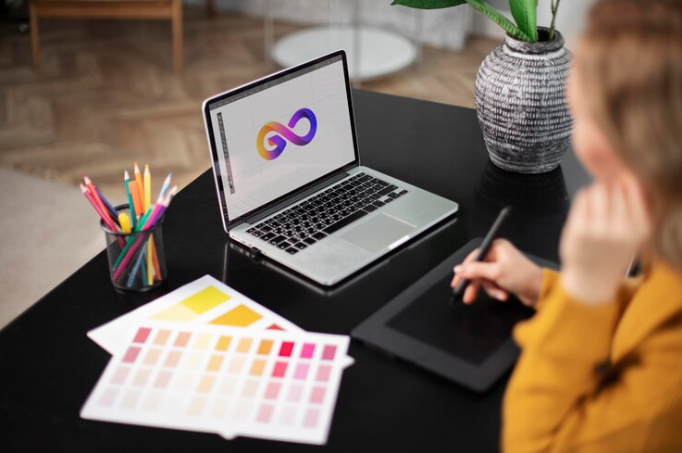In today’s competitive market, a logo is often the first impression of your brand. It encapsulates your company’s personality, mission, and values, all in a single, recognizable image. But what makes a logo effective? What are the core design principles that work across industries and time?
In this post, we’ll dive into the top 10 logo design concepts that are not only trendy but have stood the test of time in creating memorable, impactful logos for brands of all sizes.
Top 10 Best Logo Design Concepts
1. Minimalist Design: Less is More
Minimalism is all about stripping away unnecessary elements. The result? A clean, simple, and highly recognizable logo. Often characterized by basic geometric shapes and a limited color palette, minimalist logos focus on the essence of the brand, making them instantly memorable.
Examples: Apple, Nike
Why It Works: A minimalist logo is versatile, timeless, and easy to reproduce across various mediums. It is especially effective in the digital age where logos need to adapt to different screen sizes and devices.
2. Typographic Logos: The Power of Words
A typographic logo, also known as a wordmark, relies solely on the company’s name, often with unique fonts or letter arrangements. This type of logo focuses on legibility, brand identity, and style through custom fonts or typography.
Examples: Google, Coca-Cola
Why It Works: Wordmarks work well for companies with strong names and distinctive identities. They help establish immediate recognition while highlighting the name itself.
3. Lettermarks: Initials for Impact
Lettermarks, or monogram logos, use the initials or a short version of the company’s name to create a recognizable logo. These logos often focus on typography and may use a stylized font or unique formatting.
Examples: IBM, HP
Why It Works: Lettermarks are ideal for businesses with long names or complex brand identities. They simplify the brand into something easier to remember and reproduce.
4. Pictorial Marks: Icons That Speak
Pictorial marks are icon-based logos that represent the brand through a specific image or symbol. These logos can be abstract or literal, often reflecting a key attribute of the business.
Examples: Twitter (bird), Target (bullseye)
Why It Works: Pictorial marks create an emotional connection and offer a visual shorthand for the brand. They’re ideal for companies that want to convey a specific idea or value through a simple image.
5. Abstract Logos: Bold and Unique
Abstract logos use shapes and designs that don’t represent real-world objects but instead convey a mood, concept, or idea that’s unique to the brand. These logos are often artistic and visually striking.
Examples: Pepsi, Adidas
Why It Works: An abstract logo offers flexibility and room for interpretation, making it distinctive and versatile. It also allows brands to establish a more universal identity that’s not tied to specific imagery.
6. Emblems: Classic and Authoritative
Emblem logos are characterized by text within a symbol or icon, often taking the form of badges, seals, or crests. These logos have a traditional, formal feel and are commonly used by organizations or companies that want to evoke a sense of trust and authority.
Examples: Harley-Davidson, Starbucks
Why It Works: Emblems create a sense of heritage and reliability. They’re particularly effective for companies in the automotive, sports, and education sectors.
7. Mascot Logos: Character-Based Designs
Mascot logos feature a character—often a person, animal, or mascot—that represents the brand. These logos can be playful, relatable, and engaging, helping brands develop a friendly or approachable persona.
Examples: KFC (Colonel Sanders), Michelin (Michelin Man)
Why It Works: Mascot logos build an emotional connection with the audience. They can be especially effective for brands targeting younger demographics or those looking to build a fun, approachable identity.
8. Dynamic Logos: Adapting to the Times
A dynamic or responsive logo changes depending on the platform, audience, or context. These logos might have different variations for digital and print or adapt their appearance for special occasions or marketing campaigns.
Examples: Google Doodles, Burger King (changing logos for special campaigns)
Why It Works: A dynamic logo keeps the brand fresh and relevant. It allows for creativity and adaptability without losing the core identity of the brand.
9. Negative Space: Clever and Intriguing
Negative space logos make use of the empty space around and within elements of the design to create hidden messages or images. This concept plays with perception and can create a visual “aha” moment for viewers.
Examples: FedEx (hidden arrow), NBC (peacock)
Why It Works: Negative space logos are memorable and often generate a sense of surprise and intrigue. They’re perfect for companies that want to communicate creativity and intelligence in their branding.
10. Geometric Logos: Clean and Balanced
Geometric logos are built using simple shapes like circles, squares, and triangles. These logos rely on symmetry, balance, and precision to communicate a sense of stability and professionalism.
Examples: MasterCard, Pepsi
Why It Works: Geometric logos are timeless and work well in almost any context, from digital screens to billboards. They’re clean, professional, and easily scalable.
The Right Logo for Your Brand
Your logo is one of the most important elements of your brand identity. It’s more than just a graphic; it’s a symbol of your values, your mission, and the connection you share with your audience. The top 10 logo design concepts we’ve covered all offer different ways to express a brand’s personality and vision.
When choosing the right concept for your logo, consider your company’s industry, target audience, and long-term goals. Whether you opt for a minimalist design or a more intricate emblem, the key is to create a logo that’s memorable, scalable, and authentic to your brand.
If you’re ready to create a standout logo for your business, keep these concepts in mind as a starting point for your design journey. After all, your logo is the first impression you’ll make on potential customers—make it count!
Share this content:

